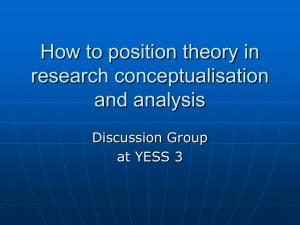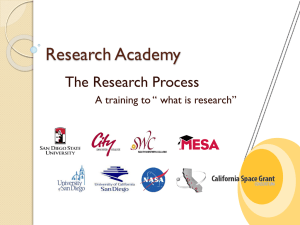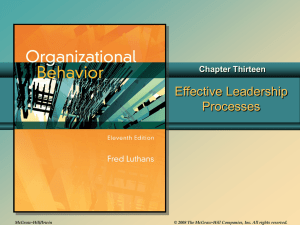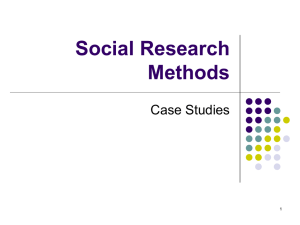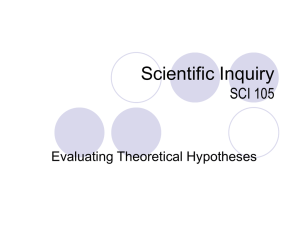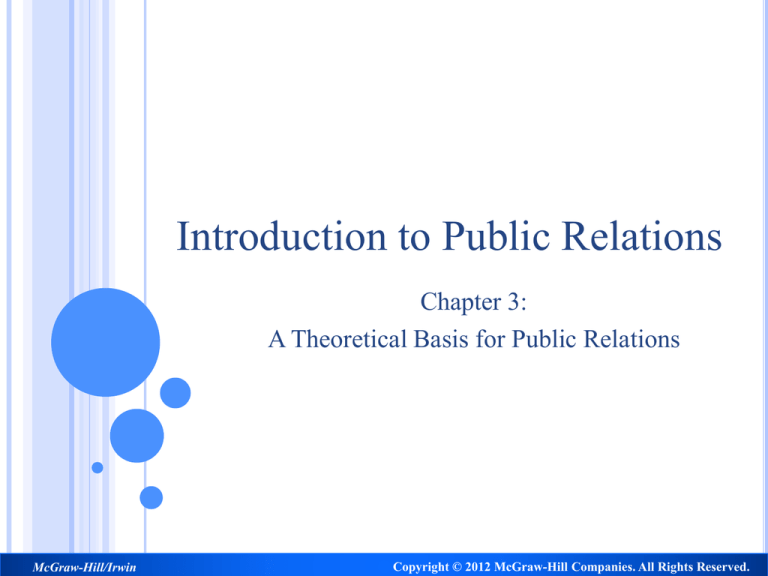
Introduction to Public Relations
Chapter 3:
A Theoretical Basis for Public Relations
McGraw-Hill/Irwin
Copyright © 2012 McGraw-Hill Companies. All Rights Reserved.
Introduction to Public Relations
Theoretical Basis
WHY UNDERSTAND THEORY?
Theories help practitioners explain and predict human
behavior and guide organizational decision making.
3-2
Introduction to Public Relations
Theoretical Basis
CONNECTING THEORIES WITH PUBLIC RELATIONS
What is theory?
A theory is a prediction of how the world will work
under certain circumstances.
How do theories help the PR practitioner?
Applying theories correctly can help campaigns and
messages be more effective (i.e. more supportive of
accomplishing organizational goals).
3-3
Introduction to Public Relations
Theoretical Basis
THEORIES OF RELATIONSHIPS
Cause-effect principles or theories can guide you in
understanding how organizations relate to their publics.
Systems theory
Situational theory
3-4
Introduction to Public Relations
Theoretical Basis
SYSTEMS THEORY
Definition: The attitudes and actions of an organization
or public contribute to a cause-effect chain reaction
within their environment.
Organizations and publics exist in relationship to each
other, meaning the actions of one affects the actions and
reactions of the others.
3-5
Introduction to Public Relations
Theoretical Basis
APPLYING SYSTEMS THEORY TO PR
Helps the practitioner manage the organization’s
relationships.
Emphasizes interdependence between an organization and
its internal and external environments.
Two types of systems
Open
Closed
3-6
Introduction to Public Relations
Theoretical Basis
OPEN SYSTEMS
Focuses on input from external publics and the
organization’s external environment.
Allows for the two-way flow of information between an
organization and its environment
3-7
Introduction to Public Relations
Theoretical Basis
CLOSED SYSTEM
Focuses on the history of the organization and makes
decisions based on past experiences.
3-8
Introduction to Public Relations
Theoretical Basis
SITUATIONAL THEORY
Definition: People will act on an issue or
situation when they believe it affects them
personally and their actions can make a
difference.
Three variables:
Problem recognition: People must be able
to see the potential of an issue to affect
them personally.
Constraint recognition: People must see
that they can do something about the
issue.
Level of involvement: People must care
about resolving the issue.
3-9
Introduction to Public Relations
Theoretical Basis
TWO BENEFITS OF SITUATIONAL THEORY
Helps the practitioner predict when groups will become
active or remain apathetic.
Helps the practitioner create communication strategies for
specific publics.
Determine status with respect to each of the three variables
Determine potential strategies to address “deficient” variables
Choose final strategy
3-10
Introduction to Public Relations
Theoretical Basis
PUBLIC OPINION THEORIES
What are attitudes?
What are opinions?
Is there any interaction between attitudes and opinions?
What is cognitive dissonance?
Are we influenced by rational or irrational reasoning?
3-11
Introduction to Public Relations
Theoretical Basis
SHAPING PUBLIC OPINION
What are attitudes?
Predispositions to respond in a given way to an issue
or situation
What are opinions?
Can be an expression of an attitude on a controversial
issue.
Can be a more “temporary” (i.e. state-driven) reaction
to an issue
3-12
Introduction to Public Relations
Theoretical Basis
PR OBJECTIVES FOR SHAPING OPINION
Conserve Favorable Opinion
Crystallize uninformed, or latent opinion
Change/neutralize hostile opinion
3-13
Introduction to Public Relations
Theoretical Basis
COGNITION AND BEHAVIOR
Cognitive theories deal with thought processes while
behavioral theories deal with action.
Cognitive Theories
Words and actions are given personalized meanings by
receivers, and sometimes that meaning is not what was
intended by the sender.
Practitioners seek to influence the publics’
interpretations to accurately reflect the original intent.
Example: Company expansion and growth (may be perceived as
negative)
3-14
Introduction to Public Relations
Theoretical Basis
THEORIES OF PERSUASION & SOCIAL INFLUENCE
Explain how humans think and behave in relation to one
another
Three common theories include
Social exchange theory
Diffusion theory
Social learning theory
3-15
Introduction to Public Relations
Theoretical Basis
SOCIAL EXCHANGE THEORY
Uses the economic metaphor of costs and benefits to
predict behavior
In general people want their costs to be low and rewards
to be high (is this logical?)
Practitioners look at how publics evaluate costs and
rewards to demonstrate and maximize the net benefits of
particular action.
Example: Persuading voters or consumers to take a survey
Example: Product recalls
Example: Passing a new law
3-16
Introduction to Public Relations
Theoretical Basis
DIFFUSION THEORY
Individuals are influenced to diffuse and adopt an idea in
five stages.
1. Awareness
2. Interest
3. Evaluation
4. Trial
5. Adoption
Mass media is useful in the first two stages, and personal
influence is needed in the next two before adoption takes
place.
The “information trap”
3-17
Introduction to Public Relations
Theoretical Basis
THE FIVE STAGES OF ADOPTION
1. Awareness – Topic known but knowledge limited.
•
Stage engages the mass media
2. Interest – Development of interest begins; information sought.
•
Stage engages the mass media
3. Evaluation – Idea applied to individual situations, more information
obtained.
•
Stage engages unbiased third parties
4. Trial – Use begins on a small scale.
•
Stage engages unbiased third parties
5. Adoption – Idea, service or product adopted after being proven
worthwhile.
•
Stage engages personal experience
3-18
Introduction to Public Relations
Theoretical Basis
SOCIAL LEARNING THEORY
Social Psychologist Albert Bandura suggests that we can
learn new behaviors by observing others.
When we see a behavior leading to a reward we value,
we may adopt that behavior for ourselves.
Example: In employee relations we can see that if
inappropriate behavior is rewarded for one employee, others
may adopt this inappropriate behavior pattern.
3-19
Introduction to Public Relations
Theoretical Basis
SUMMARY OF THEORIES ABOUT COGNITION &
BEHAVIOR
Social Exchange Theory: people act in ways that reduce
costs and increase rewards.
Diffusion Theory: people can be influenced to diffuse
and adopt ideas through five stages.
Social Learning Theory: people can be influenced by
seeing how others are rewarded for particular actions.
3-20
Introduction to Public Relations
Theoretical Basis
THEORIES OF MASS COMMUNICATION
There are three theories that help us understand the powerful
influence of media.
Use and Gratification Theory
Framing Theory
Agenda Setting Theory
3-21
Introduction to Public Relations
Theoretical Basis
A DEFINITION OF MEDIA
The English word media is a Latin derivative of medius,
meaning middle.
For our purposes we define media as…
all the means of communication, such as newspapers, radio,
TV, the internet/mobile technologies that provide the public
with news, entertainment, etc., usually along with
advertising (Webster’s New World College Dictionary,
1999).
Traditional Mass Media vs. New Media
3-22
Introduction to Public Relations
Theoretical Basis
USE AND GRATIFICATIONS THEORY
People are active users of media and choose
how and when to use media based on its
gratification for them.
Reasons for media usage include…
for entertainment
to scan the environment for items that are
important to them
as a diversion
as a substitute for personal relationships
as a check on self-identity
Why do you pay attention to the media?
3-23
Introduction to Public Relations
Theoretical Basis
APPLICATION FOR THE PRACTITIONER
The use and gratification theory helps the practitioner
explain media effects, or the absence of effects.
The practitioner must remember that just because a message
is available doesn’t mean that people will pay attention to,
remember or even understand it (or its implications).
3-24
Introduction to Public Relations
Theoretical Basis
FRAMING THEORY
Theory supposes that media messages may carry with
them a pre-existing (implicit) set of meanings and
associations.
People tend to process information in the way in which it
is presented to them (i.e. contextualized).
Catchphrases or visual images
“The War on Terror” or “Terrorism”
“Sustainability”
“Occupy Wall Street”
“Public Welfare”
3-25
Introduction to Public Relations
Theoretical Basis
AGENDA SETTING THEORY
Agenda Setting is based on the assumption that although
media can’t tell people what to think about an issue, it can
influence what issues people think about.
Media has the potential to increase issue salience.
3-26
Introduction to Public Relations
Theoretical Basis
MODELS OF PUBLIC RELATIONS
Press agentry: oldest form of public relations practice
where propaganda tactics, special events, and “guerilla”
tactics are used. Little regard for research or ethics.
Public Information: intent is to inform through one-way
information such as press releases.
Two-way asymmetrical model: scientific persuasion using
social science methods to increase persuasiveness of
messages.
Two-way symmetrical model: depicts public relations
orientation in which organizations and public adjust to each
other. It focuses on the use of social science methods to
achieve mutual understanding and two-way communication
3-27
Introduction to Public Relations
Theoretical Basis
NEWER MODELS FOR THE PR PRACTICE
Jim Grunig has developed numerous
models that more effectively explain
how public relations works
Personal Influence model: Practitioners develop personal
relationships with key individuals because of their
influence. (as easy as it sounds?)
Cultural Interpreter model: Establishes that to do effective
public relations in another country, the practitioner needs to
work with someone who understands the local language,
culture, customs and politics.
3-28
Introduction to Public Relations
Theoretical Basis
APPROACHES TO CONFLICT RESOLUTION
Conflicts involve an individual or group actively opposing
another because of differences in values and goals.
Four resolution elements:
Separate the people from the problem.
Focus on interests, not positions.
Invent options for mutual gain.
Insist on objective criteria: What are the facts?
3-29

